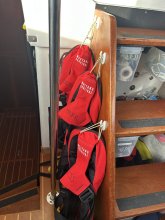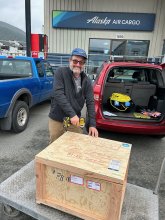We had an excellent berth at the Auke Bay Marina, Juneau, AK—complete with a view and a to-do list that that was as long as a Costco receipt. Luckily, we had a few days to tackle it all.
The big project—the hurricane furnace exhaust upgrade—was covered in the last report. I’m still smiling about how well it performed. On the crossing, we ran into an unpredicted wind event, with gusts hitting the 30s and occasionally close to 40 knots. While the wind caused a couple of flameouts (it was blowing straight into the exhaust), we had zero seawater intrusion. That’s a big win.
We enjoyed a few meals out and hit Fred Meyer and Costco with the enthusiasm of sailors who hadn’t seen been to port in a while. Here’s what I focused on in port:
Diesel Fuel
First up: fuel and oil. We motored to the fuel dock first thing and topped off. We run the engine conservatively at 1500 RPM to maximize our range, which we’ll need for the longer legs ahead—forecasted light winds make that a priority. Also, this gives us 6 knots of quiet/smooth cruising, life at 6 knots!
We took on 170.6 gallons in Juneau. Initially, my calculations looked amazing—too amazing. Turns out, I forgot to include the 50 gallons we added while staying in Daajing Giids (Haida Gwaii). We thought we might need that to reach Juneau, but we ended up not burning through the 200 liters we had purchased. Once I corrected the numbers, here’s what we had:
- Furnace tank: 18.6 Gallons for 3 weeks.
- Main tank: 152 Gallons, plus 50 @ Haida Gwaii
The furnace is rated at 0.48 GPH, but since it cycles on and off, it’s tricky to pin down. Using a dedicated tank, we estimated around 6 gallons per week during 48°F, mostly cloudy weather. We expect it to drop another 10°F farther north, but that shouldn’t dramatically increase our usage for heat and hot water.
Next report will include detailed fuel consumption reporting.
Propane
Propane on One Ocean is for cooking only—heat and hot water are diesel-based. Our Dickinson Mediterranean stove/oven continues to impress. For refills, we got some local advice: “Talk to Sailboat Bob.”
So, we did. Tanks were loaded into the dinghy (avoiding a long dock walk), and we topped both up at a nearby service station. One tank, used just a week, only took ½ gallon. With two tanks holding roughly 8 gallons total, we’re well-stocked for the Northwest Passage. We’ll top them off again in Unalaska & Nome just to be safe.
Machinery
Engine Oil:
During the propane run, we picked up 2 gallons of gas for the dinghy. Our Yamaha 6HP is fuel-efficient, but we’ve been using it a lot—kelp studies keep us moving. The Yamaha’s built-in ½ gallon tank serves as our reserve. At the fuel dock, I noticed a mountain of Delo oil. Rather than lugging it from town, I grabbed a couple of cases and tossed them in the dinghy—direct-to-boat delivery!
We had 164 hours on the engine (the change interval is 250), but the convenience was too good to pass up. A built-in pump made the oil change painless. Everything looked good, aside from a minor weep at the transmission output seal. We placed clean white absorbent pads under the engine and called it good for ocean miles ahead.
Generator:
Happy to report we could have gotten by without it so far. With only 6 hours logged, all it needed was a solid inspection. It's ready for action when battery charging becomes necessary.

Last-Minute Upgrades
As we made our way up the Inside Passage, we continued refining One Ocean to make it even more crew-friendly.
- iPad Mount: Tim installed a custom mount at the inside helm. It turned out great. Sadly, he flew home from Juneau—we’ll miss him. He was a fantastic addition to the crew.
- Image
 Everything needs a place
Everything needs a place - USB Power: We realized we needed more USB ports to charge our iPad and GPS. A quick trip to Western Auto & Marine solved it, though I’m sure I already stashed extras aboard during the refit… somewhere. Captain Mark mounted it, I wired it—mission complete
- Lifejacket Hooks: On the first day out, while motoring in light winds, Mark installed hooks on the companionway stairs for our life jackets. Works like a charm.

Special Delivery: New ROV “Jonah”
A big thank you to the Center of Excellence in Marine Manufacturing for sending us a new underwater ROV to replace
our older, occasionally quirky unit. Instructor Matt at the Marine Tech Center built a custom crate, and the swap took only minutes at the Alaska Airlines Cargo hub. The new ROV comes with new features—we're excited to test it in the Northwest Passage!
The Alternator Saga (Because Boats...)
Though the boat came with a solid 200-amp Balmar alternator, we upgraded to a 360-amp 12V APS unit, keeping the old one as a spare. The install was straightforward... mostly.
Despite the nice serpentine belt kit already in place, the alignment was just off enough to cause the belt to jump a groove on the water pump pulley and start shredding. Mark and I pulled the alternator, found an incorrectly placed washer that was pushing it aft, and shimmed it forward.
We thought we nailed it. Until we left Juneau.
After witnessing a bubble-net feeding frenzy by some humpbacks (amazing!), I popped my head into the engine space and—ugh—the belt had now jumped forward. I removed a spacer on the top bracket (10-minute fix vs. full alternator removal). It worked—for a while. But in the Gulf of Alaska, we realized it still wasn’t right. If we were back at the Marine Tech Center, we’d use a laser alignment tool. Out here, it’s trial, error, and luck. We think we’ve got it now, but time will tell.
What’s Next
In Unalaska, we’ll conduct another full inspection, refuel, top off propane, and get ready to push north toward Nome. Oh, and naturally, fix anything new that inevitably crops up during another 1,000-mile ocean crossing. 😊
Cheers,
Mike
